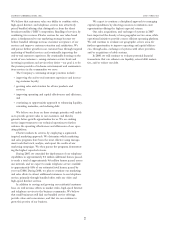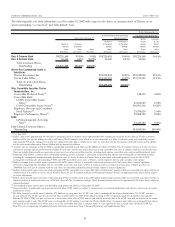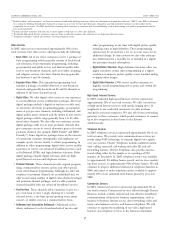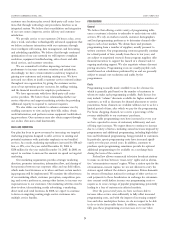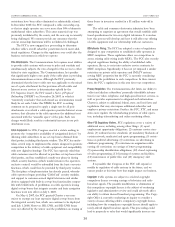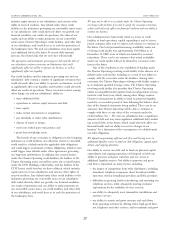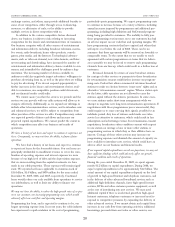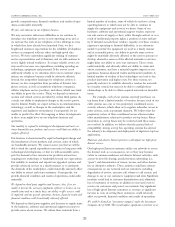Charter 2007 Annual Report Download - page 23
Download and view the complete annual report
Please find page 23 of the 2007 Charter annual report below. You can navigate through the pages in the report by either clicking on the pages listed below, or by using the keyword search tool below to find specific information within the annual report.
signals with minimal signal distortion. Certain utilities are also
developing broadband over power line technology, which may
allow the provision of Internet and other broadband services to
homes and offices. Utilities have deployed broadband over power
line technology in a few limited markets. In some cases, it is the
local municipalities that regulate us, which own cable systems
that compete with us.
Broadcast Television
Cable television has long competed with broadcast television,
which consists of television signals that the viewer is able to
receive without charge using an “off-air” antenna. The extent of
such competition is dependent upon the quality and quantity of
broadcast signals available through “off-air” reception, compared
to the services provided by the local cable system. Traditionally,
cable television has provided higher picture quality and more
channel offerings than broadcast television. However, the recent
licensing of digital spectrum by the FCC now provides traditional
broadcasters with the ability to deliver high definition television
pictures and multiple digital-quality program streams, as well as
advanced digital services such as subscription video and data
transmission.
Traditional Overbuilds
Cable systems are operated under non-exclusive franchises his-
torically granted by local authorities. More than one cable system
may legally be built in the same area. It is possible that a
franchising authority might grant a second franchise to another
cable operator and that such franchise might contain terms and
conditions more favorable than those afforded us. In addition,
entities willing to establish an open video system, under which
they offer unaffiliated programmers non-discriminatory access to
a portion of the system’s cable system, may be able to avoid local
franchising requirements. Well-financed businesses from outside
the cable industry, such as public utilities that already possess
fiber optic and other transmission lines in the areas they serve,
may over time become competitors. There are a number of cities
that have constructed their own cable systems, in a manner
similar to city-provided utility services. There also has been
interest in traditional cable overbuilds by private companies not
affiliated with established local exchange carriers. Constructing a
competing cable system is a capital intensive process which
involves a high degree of risk. We believe that in order to be
successful, a competitor’s overbuild would need to be able to
serve the homes and businesses in the overbuilt area with equal
or better service quality, on a more cost-effective basis than we
can. Any such overbuild operation would require either signifi-
cant access to capital or access to facilities already in place that
are capable of delivering cable television programming.
As of December 31, 2007, excluding telephone companies,
we are aware of traditional overbuild situations impacting
approximately 7% to 8% of our total homes passed and potential
traditional overbuild situations in areas servicing approximately
an additional 2% of our total homes passed. Additional overbuild
situations may occur.
Private Cable
Additional competition is posed by satellite master antenna
television systems, or SMATV systems, serving multiple dwelling
units, or MDUs, such as condominiums, apartment complexes,
and private residential communities. Private cable systems can
offer improved reception of local television stations, and many of
the same satellite-delivered program services that are offered by
cable systems. SMATV systems currently benefit from operating
advantages not available to franchised cable systems, including
fewer regulatory burdens and no requirement to service low
density or economically depressed communities. The FCC
recently adopted regulations that favor SMATV and private cable
operators serving MDU complexes, allowing them to continue to
secure exclusive contracts with MDU owners. The FCC regula-
tions have been appealed, and the FCC is currently considering
whether to restrict their ability to enter into exclusive arrange-
ments, but this sort of regulatory disparity, if it withstands judicial
review, provides a competitive advantage to certain of our
current and potential competitors.
Other Competitors
Local wireless Internet services have recently begun to operate in
many markets using available unlicensed radio spectrum. Some
cellular phone service operators are also marketing PC cards
offering wireless broadband access to their cellular networks.
These service options offer another alternative to cable-based
Internet access.
High-speed Internet access facilitates the streaming of video
into homes and businesses. As the quality and availability of
video streaming over the Internet improves, video streaming
likely will compete with the traditional delivery of video pro-
gramming services over cable systems. It is possible that pro-
gramming suppliers will consider bypassing cable operators and
market their services directly to the consumer through video
streaming over the Internet.
REGULATION AND LEGISLATION
The following summary addresses the key regulatory and legisla-
tive developments affecting the cable industry and our three
primary services: video service, high-speed Internet service, and
telephone service. Cable system operations are extensively regu-
lated by the federal government (primarily the FCC), certain
state governments, and most local governments. A failure to
comply with these regulations could subject us to substantial
penalties. Our business can be dramatically impacted by changes
to the existing regulatory framework, whether triggered by
legislative, administrative, or judicial rulings. Congress and the
FCC have frequently revisited the subject of communications
regulation often designed to increase competition to the cable
industry, and they are likely to do so in the future. We could be
materially disadvantaged in the future if we are subject to new
regulations that do not equally impact our key competitors. We
can provide no assurance that the already extensive regulation of
our business will not be expanded in the future.
CHARTER COMMUNICATIONS, INC. 2007 FORM 10-K
12


